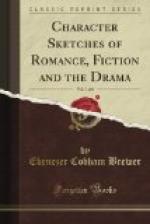Alic’ia (The lady), daughter of lord Waldemar Fitzurse.—Sir W. Scott, Ivanhoe (time, Richard I.).
ALICK [POLWORTH], one of the servants of Waverley.—Sir W. Scott, Waverley (time, George II.).
ALIFAN’FARON, emperor of the island Trap’oban, a Mahometan, the suitor of Pentap’olin’s daughter, a Christian. Pentapolin refused to sanction this alliance, and the emperor raised a vast army to enforce his suit. This is don Quixote’s solution of two flocks of sheep coming in opposite directions, which he told Sancho were the armies of Alifanfaron and Pentapolin.—Cervantes, Don Quixote, I. iii. 4 (1605).
Ajax the Greater had a similar encounter. (See AJAX.)
ALIN’DA, daughter of Alphonso, an irascible
old lord of
Sego’via.—Beaumont and Fletcher,
The Pilgrim (1621).
(Alinda is the name assumed by young Archas when he dresses in woman’s attire. This young man is the son of general Archas, “the loyal subject” of the great duke of Moscovia, in the drama by Beaumont and Fletcher, called The Loyal Subject, 1618.)
ALIPRANDO, a Christian knight, who discovered the armor of Rinaldo, and took it to Godfrey. Both inferred that Rinaldo had been slain, but were mistaken.—Tasso, Jerusalem Delivered (1575).
AL’IRIS, sultan of Lower Buchar’ia, who, under the assumed name of Fer’amorz, accompanies Lalla Rookh from Delhi, on her way to be married to the sultan. He wins her love, and amuses the tedium of the journey by telling her tales. When introduced to the sultan, her joy is unbounded on discovering that Feramorz the poet, who has won her heart, is the sultan to whom she is betrothed.—T. Moore, Lalla Rookh.
ALISAUNDER (Sir), surnamed LORFELIN, son of the good prince Boudwine and his wife An’glides (3 syl.). Sir Mark, king of Cornwall, murdered sir Boudwine, who was his brother, while Alisaunder was a mere child. When Alisaunder was knighted, his mother gave him his father’s doublet, “bebled with old blood,” and charged him to revenge his father’s death. Alisaunder married Alis la Beale Pilgrim, and had one son called Bellen’gerus le Beuse. Instead of fulfilling his mother’s charge, he was himself “falsely and feloniously slain” by king Mark.—Sir T. Malory, History of King Arthur, ii. 119-125 (1470).
AL’ISON, the young wife of John, a rich old miserly carpenter. Absolon, a priggish parish clerk, paid her attention, but she herself loved a poor scholar named Nicholas, lodging in her husband’s house. Fair she was, and her body lithe as a weasel. She had a rouguish eye, small eyebrows, was “long as a mast and upright as a bolt,” more “pleasant to look on than a flowering pear tree,” and her skin “was softer than the wool of a wether.”—Chaucer, “The Miller’s Tale,” Canterbury Tales, (1388).
Al’ison, in sir W. Scott’s Kenilworth, is an old domestic in the service of the earl of Leicester at Cumnor Place.




